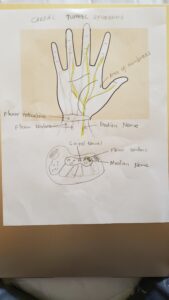Carpal tunnel syndrome is a common condition that causes pain, numbness, and tingling in the arm and hands. The condition occurs when when one of the major nerves to the hand- the median nerve- is squeezed o compressed as it travels through the wrist.

Carpal Tunnel Syndrome (CTS) is easily one of the most common syndromes to appear on a day-to-day basis. Targeting mainly middle-aged individuals or older, women are disproportionately affected, with three women obtaining the syndrome to every man. This nerve syndrome involves the median nerve and the carpal tunnel. The median nerve is a nerve that runs through a passage in the wrist, called a carpal tunnel; this nerve provides necessary nerve signals for motor function. Any swelling around the carpal tunnel can cut the nerve off from transferring signals back and forth, leading to such effects as numbness and tingling of fingers and general weakness of the hand. One major factor that contributes to this disease is heavy, repetitive work; this is why CTS is common in workers that perform intense assembly line work. Prevention of CTS includes using a splint at night to relieve tension put on the median nerve and constant stretching of the hands, as well as fingerless gloves; preventing CTS is advantageous in the long run, as long-term damage can cause nerves to whittle away. One method of treatment involves anti-inflammatory pain meds, which may temporarily reduce swelling around the area and offer a short solution; however, more intensive treatments include open carpal tunnel release surgery. This surgery separates the ligaments around the carpal tunnel in order to release pressure on the area and allows for the free flow of signals from the median nerve to continue uninhibited. However, this option is usually a worst-case scenario, usually when other methods have already failed.
Carpal tunnel syndrome, also called median nerve compression, is a condition that causes numbness, tingling, or weakness in your hand. It happens due to pressure on your median nerve, which runs the length of your arm, goes through a passage in your wrist called the carpal tunnel, and ends in your hand.
Warning signs are tingling or numbness. You may notice tingling and numbness in your fingers or hand. Usually the thumb and index, middle or ring fingers are affected, but not your little finger.
You may experience weakness in your hand and drop objects!
The muscles of the hands or wrists are weak and actually getting smaller because of the severe pinching of the median nerve. The symptoms of carpal tunnel syndrome have lasted 6 months or longer with no relief.
Massage therapy is an effective way to help relieve CTS-related symptoms and can be used as a preventative measure. Massage therapy can help treat CTS by reducing inflammation, pain, and numbness in the carpal tunnel. This happens by lengthening the muscles and fascia in the neck, shoulders, arms, wrists, and hand.